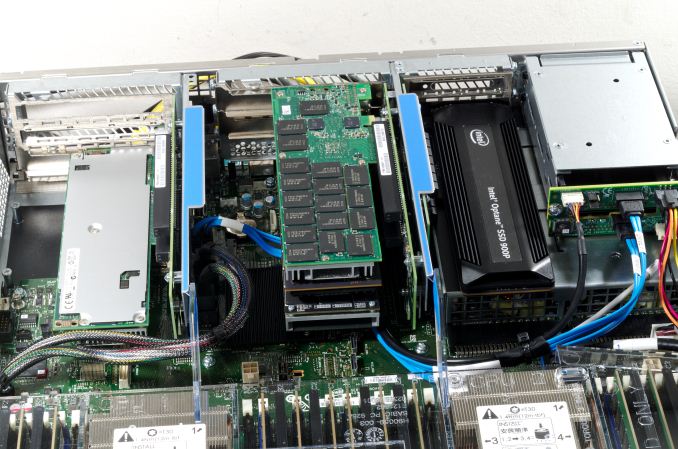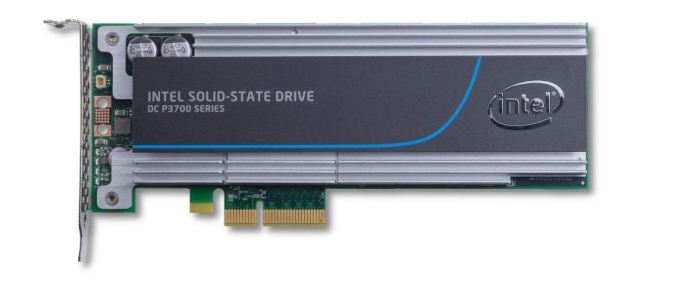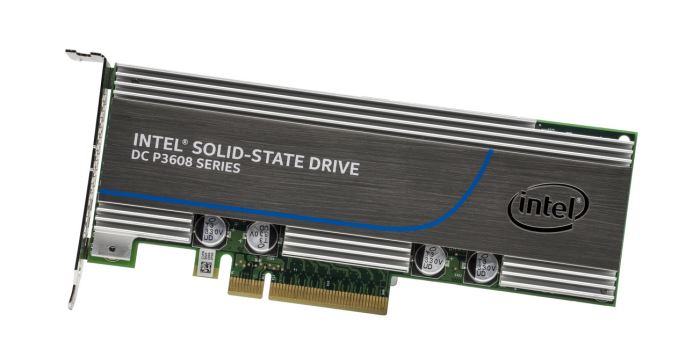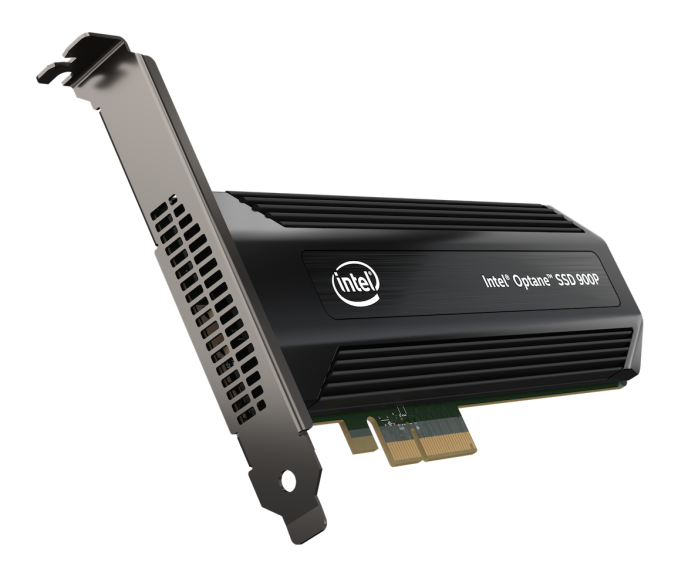Intel Optane SSD DC P4800X 750GB Hands-On Review
by Billy Tallis on November 9, 2017 12:00 PM ESTTest System
Along with the Optane SSD sample, Intel provided a new server based on their latest Xeon Scalable platform for our use as a testbed. The 2U server is equipped with two 18-core Xeon Gold 6154 processors, 192GB of DRAM, and an abundance of PCIe lanes.
Because this is a dual-socket NUMA system, care needs to be taken to avoid unnecessary data transfers between sockets. For this review, the tests were setup to largely emulate a single-socket configuration: All SSDs tested for this review were connected to PCIe ports provided by CPU #2. All of the benchmarks using the FIO tool were configured to only use cores on CPU #2 and only allocate memory connected to CPU #2, so inter-socket latency is not a factor. This setup would be quite limiting when doing full enterprise application testing, but for synthetic storage benchmarks one CPU is far more than necessary to stress any single SSD.
For this review, the test system was mostly configured to offer the highest and most predictable storage performance. HyperThreading was disabled, SpeedStep and processor C-states were off, and other motherboard settings were set for maximum performance. The one notable exception is fan speeds: since this test server was installed in a home office environment instead of a datacenter, the "acoustic" fan profile had to be used instead of "performance".
| Enterprise SSD Test System | |
| System Model | Intel Server R2208WFTZS |
| CPU | 2x Intel Xeon Gold 6154 (18C, 3.0GHz) |
| Motherboard | Intel S2600WFT |
| Chipset | Intel C624 |
| Memory | 192GB total, Micron DDR4-2666 16GB modules |
| Software | Linux kernel 4.13.11 FIO 3.1 |
The Linux kernel's NVMe driver is constantly evolving, and several new features have been added this year that are relevant to a drive like the Optane SSD. Rather than use an enterprise-oriented Linux distribution with a long-term support cycle for an older kernel version, this review was conducted using the very fresh 4.13 kernel series.
Earlier this year, the FIO storage benchmarking tool hit a major milestone with version 3.0 that switches timing measurements from microsecond precision to nanosecond precision. This makes it much easier to analyze the performance of Optane devices, where latency can be down in the single-digit microsecond territory.
The Competition
Intel SSD DC P3700 1.6TB
The Intel SSD DC P3700 was the flagship of their first generation of NVMe SSDs, and one of the first widely available NVMe SSDs. It was a great showcase for the advantages of NVMe, but is now outdated with its use of 20nm planar MLC NAND and capacities that top out at 2TB.
Intel launched a new P4x00 generation of flash-based enterprise NVMe SSDs this year using a new controller and 3D TLC NAND. However, due to the existence of the Optane SSD DC P4800X as the new flagship drive, the P3700 didn't get a direct successor: the P4600 is currently Intel's top flash-based enterprise SSD, and while it offers higher performance and capacities than the P3700 it does not match the rated write endurance of the P3700.
Intel SSD DC P3608 1.6TB
Intel's first-generation NVMe controller only supports drive capacities up to 2TB. To get around that limitation and to offer higher performance in some respects, Intel created the SSD DC P3608. Roughly equivalent to two P3600s on one card behind a PLX PCIe switch, the P3608 appears to the system as two SSDs but can be used with software RAID to create a large, high-performance volume. Our P3608 sample has a total of 1.6TB of accessible storage (800GB per controller) and has the highest built-in overprovisioning ratios in the P3608 family. This gives it the best aggregate random write performance, which is rated to match a single P3700 while random reads and sequential transfers can exceed the P3700.
For this review, one controller on the P3608 was tested as a stand-in for the P3600, and a software RAID 0 array spanning both controllers was also tested.
Intel has not officially announced the successor P4608, but they have submitted it for testing and inclusion on the NVMe Integrators List, so it will probably launch within the next few months.
Micron 9100 MAX 2.4TB
Launched in mid 2016, the Micron 9100 series was part of their first generation of NVMe SSDs. Micron wasn't new to the PCIe SSD market, but their early products predated the NVMe standard and instead used a proprietary protocol. The 9100 series uses Micron 16nm MLC NAND flash and a Microsemi Flashtec NVMe1032 controller.
Our Micron 9100 MAX 2.4TB sample is the fastest model from the 9100 series, and the second-largest. Micron recently announced the 9200 series that switched to 3D TLC NAND for a huge capacity boost and adopted the latest generation of Microsemi controllers to allow for a PCIe x8 connection, but we don't have a sample.
Intel Optane SSD 900p 280GB
Last month, Intel launched their consumer Optane SSD based on the same controller platform as the P4800X. The Optane SSD 900p has some enterprise-oriented features disabled and is rated for only a third the write endurance, but offers essentially the same performance as the P4800X for about a third the price.
This makes the 900p a very attractive option for users who need Optane level of performance but don't want to pay for the absolute highest write endurance. It isn't intended as an enterprise SSD, but the 900p can compete in this space.















58 Comments
View All Comments
Elstar - Thursday, November 9, 2017 - link
I thought the whole point of 3D XPoint memory would be that it is DIMM friendly too.1) When will we see this in DIMM form?
2) Would the DIMM version also need/have the reserved/spare capacity?
3) Why is this spare capacity even needed? 1/6th seems like a potentially high internal failure rate (or other fundamental problem.)
PeachNCream - Thursday, November 9, 2017 - link
It seems like current 3D XPoint doesn't have enough endurance yet to sit in a DIMM slot unless it's gonna be just a storage drive in DIMM form factor. That and because we're only just now seeing early enterprise and retail products, I bet that we're gonna need another generation or two before we get DIMM versions. :(Billy Tallis - Thursday, November 9, 2017 - link
Intel hasn't said much about 3D XPoint DIMMs this year, other than to promise we'll hear more next year.It's not clear how much fault tolerance Intel is trying to build in to the Optane SSDs with the extra capacity. A bit of it is necessary to support sector formats with protection information (eg. 16 extra bytes per 512B sector, or 128B extra for each 4kB sector). Beyond that, there needs to be room for the drive's internal data structures, which aren't as complicated as a flash translation layer but still impose some space overhead. The rest is probably taken by a fairly simple erasure coding/ECC scheme, because it's almost impossible to do LDPC at the speed necessary for this drive. (That's also why DIMMs use simple ECC instead of more space-efficient codes.)
woggs - Thursday, November 9, 2017 - link
Most all intel SSDs have a parity die, so one full die likely provides internal raid protection of data. The rest is for ECC, internal system information, media management and mapping out defects... Impossible to know which of these is driving the actual spare implemented. I count 14 packages, so 1/14th (7%) is already the internal parity. 16% is big relative to nand consumer SSDs but comparable to enterprise. Doesn't seem particularly out of line or indicative of something wrong.CheapSushi - Thursday, November 9, 2017 - link
Micron is probably working on the DIMM version.woggs - Tuesday, November 14, 2017 - link
Intel is working on DIMMs... "Now, of course, SSDs are important, but in the long run, Intel also wants to have Optane 3D XPoint memory slot into the same sockets as DDR4 main memory, and Krzanich brought a mechanical model of an Optane DIMM to show off." https://www.nextplatform.com/2015/10/28/intel-show...MajGenRelativity - Thursday, November 9, 2017 - link
I enjoyed the review. Keep up the good work!melgross - Thursday, November 9, 2017 - link
I’m curious as to how this will perform when PCI 4 is out next year. That is, one with a PCI 4 interface. How throughput limiting is PCI 3 for this right now?MajGenRelativity - Thursday, November 9, 2017 - link
It shouldn't be that limiting, as PCIe 3.0 x4 allows for a higher throughput than 2.4 GB/s. There could be some latency improvements (probably small), but I don't think throughput is the issuewoggs - Thursday, November 9, 2017 - link
If the question is "could a drive be made to saturate gen 4?" then, yes, of course, if intel chooses to do so. Will require a whole drive. Latency is a more interesting question because that is what 3dxp is really providing. QD1 latency is <10us ((impressive!). I don't expect that to improve since it should be limited by the 3dxp itself. The PCIe and driver overhead is probably 5us of that. Maybe gen 4 will improve that part.